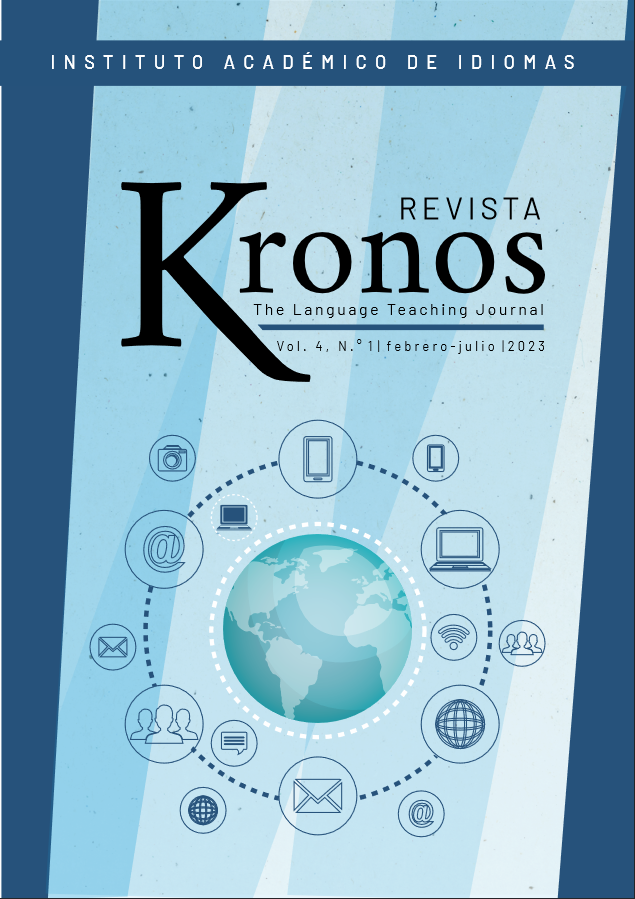Lenguaje para propósitos específicos: uso de películas hispanas y temas hispanos actuales para enseñar vocabulario específico y contexto relacionado con las profesiones en línea
DOI:
https://doi.org/10.29166/kronos.v4i1.4009Palabras clave:
Español con fines específicos, cine y cultura hispana, asuntos y profesiones hispanas, curso de conversación virtual, creación de una clase de conversación online con películas para español con fines específicos, conversaci´´on en español avanzado onlineResumen
En este estudio explico cómo se puede crear un curso avanzado de conversación en español para estudiantes virtuales que utilizan el español con fines específicos. El curso se divide en diferentes tareas que los estudiantes efectúan online teniendo en cuenta cuatro películas hispanas que son parte del contenido del curso. Este curso se imparte online y de forma asíncrona. Los estudiantes deben ver cuatro películas en este curso, tomar pruebas cortas sobre las películas y trabajar en debates y presentaciones grupales que se cargan en VT (Voice Thread). El aspecto más importante de crear un curso avanzado de conversación en español virtual es definir muy bien los objetivos y resultados del curso y encontrar las
películas que mejor sirvan para enseñar el idioma español y el vocabulario relacionado con las profesiones. La mayoría de las películas tenían un tema principal, pero también había subtemas en las películas que los estudiantes podían usar como contenidos interesantes para sus presentaciones en español.
Descargas
Citas
Amalia, E.R., Kusrini, N. R., Ramadhani, P. 2019. “Using Films to Teach Listening Comprehension.” IJEE (Indonesian Journal of English Education) 6, 2: 119-132. P- ISSN: 2356-1777, E-ISSN: 2443-0390 DOI: http://doi.org/10.15408/ijee.v6i2.14531 (This is an open access article under CC-BY-SA license (https://creativecommons.org/licenses/by-sa/4.0/)
Espino-Bravo, Chita. 2017. “Teaching Diversity in an Advanced Spanish Conversation Course Using Only Hispanic Films.” Language Magazine. Improving Literacy & Communication. https://www.languagemagazine.com/2017/06/diversity-big-screen/
Buendía Cambronero, María. 2013. “Considering Cultural Content in Language for Specific Purposes: Business Spanish Curricula.” Les langues de spécialité en Europe XXXII, no. 1: 61-74. https://journals.openedition.org/apliut/3570
Lafford, Barbara A., Abbott Ann, and Lear, Darcy. 2014. “Spanish in the professions and in the community in the US.” Journal of Spanish Language Teaching 1, no. 2: 171–186. http://dx.doi.org/10.1080/23247797.2014.970361
Mallinger, Mark, and Rossy, Gerard. 2003. “Film as a Lens for Teaching Culture: Balancing Concepts, Ambiguity, and Paradox.” Journal of Management Education 27, 5: 608-624. DOI: 10.1177/1052562903252642
Marqués-Pascual, Laura. 2019. “Contemporary Issues for Specific Purposes in the United States by Lourdes Sánchez-López.” Cuadernos de Aldeeu 3: 279-292.
Ruggiero, Diana M. 2014. "Graduate Courses in Languages for Specific Purposes: Needs, Challenges, and Models." Global Business Languages 19, Article 5: 55-69. http://docs.lib.purdue.edu/gbl/vol19/iss1/5
Trace, J., Hudson, T., & Brown, J. D. 2015. “An overview of language for specific purposes.” Developing Courses in Languages for Specific Purposes (1–23). Honolulu: University of Hawai‘I. https://core.ac.uk/download/pdf/32300318.pdf
Trace, J., T. Hudson, & J. D. Brown. 2015. “Looking Ahead in Language for Specific Purposes.” Developing Courses in Languages for Specific Purposes (272–287). Honolulu: University of Hawai‘i. doi: http://hdl.handle.net/10125/14573
Trace, J. 2015. “Looking Ahead in Language for Specific Purposes.” Developing Courses in Languages for Specific Purposes. (Part 4: Conclusion, 1-16). https://nflrc.hawaii.edu/publications/view/nw69/
Publicado
Cómo citar
Número
Sección
Licencia
Derechos de autor 1970 Chita Espino-Bravo

Esta obra está bajo una licencia internacional Creative Commons Atribución-NoComercial-CompartirIgual 4.0.












